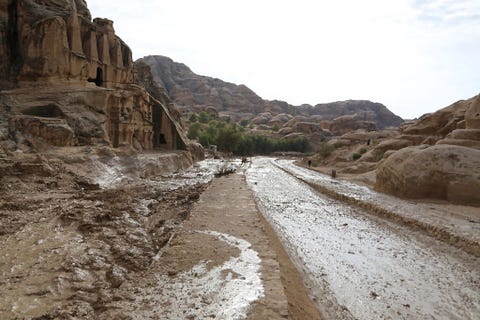Climate Change Will Bring Us Heavy Rains and Droughts at the Same Time
Ever drier soil leads to a worst-of-both-worlds scenario.
By David Grossman
GETTY IMAGES/AFP/GETTY IMAGES
Climate change has altered rainfall patterns across the globe. Heavy flooding is now more likely to occur in the United States and the rest of the planet. A new study from the University of New South Wales (UNSW) examines a paradox within this new climate—while extreme rain events are more frequent, water supplies across the globe are shrinking. The answer, the study says, lies in a worldwide phenomenon of drying soil.
From Greece to California, droughts have become increasingly regular events. Studying data from 43,000 rainfall stations and 5,300 river-monitoring sites in 160 countries, the study uses current situations on the ground, as opposed to computer models. The data show that drought-like conditions will likely become the new normal all over earth, with already dry regions getting hit the hardest.
The "long dry," as scientists call it, was a surprise.
"This is something that has been missed," says Ashish Sharma, an ARC Future Fellow at UNSW's School of Civil and Environmental Engineering, in a press statement. "We expected rainfall to increase, since warmer air stores more moisture—and that is what climate models predicted too. What we did not expect is that, despite all the extra rain everywhere in the world, is that the large rivers are drying out."
Naturally, rain often falls into catchments, or drainage basins. These catchments collect rain and eventually overflow, allowing excess rain to flow into rivers, at times causing flooding. While they can be disastrous, Sharma says, "small floods are very important for water supply, because they refill dams and form the basis of our water supply."
But soil in catchments has been warming and drying across the planet. So instead of overflowing, it's hoarding the rain.
"Less water into our rivers means less water for cities and farms. And drier soils means farmers need more water to grow the same crops. Worse, this pattern is repeated all over the world, assuming serious proportions in places that were already dry. It is extremely concerning," says Sharma.
Rainwater can be split into two categories: There's "blue water," which falls in lakes, rivers and aquifers. That rain can be used for consumption by humans. Rain that lands anywhere else is known as "green water," which is mostly retained as soil moisture. Thanks to these drying catchments and warming temperatures, for every 100 raindrops that fall on land, only 36 drops are blue water.
"It's a double whammy," says Sharma. "Less water is ending up where we can store it for later use. At the same time, more rain is overwhelming drainage infrastructure in towns and cities, leading to more urban flooding."
Past research has focused on the immediate damage to infrastructure caused by flooding. And it's no wonder why—extreme flooding in Hurricane Harvey led to $125 billion in damage. But these smaller floods are crucial to the human ecosystem. The water in Lake Mead, for example, which supplies water to southern California, Nevada, and Arizona, has been falling steadily for years.
The situation is urgent, Sharma says. "One option is to wait for international agreements to take effect, so greenhouse gas concentrations can be reined in—but this will take a long time. The other option is to be proactive, and re-engineer our water systems so we can better adapt and cope."
Source: University of New South Wales
No comments:
Post a Comment